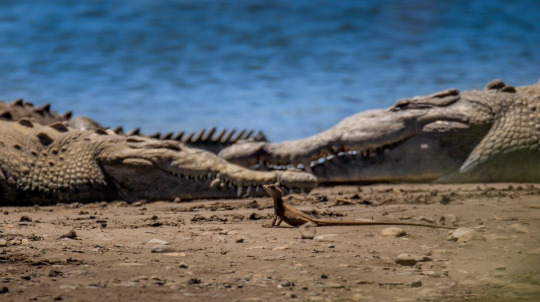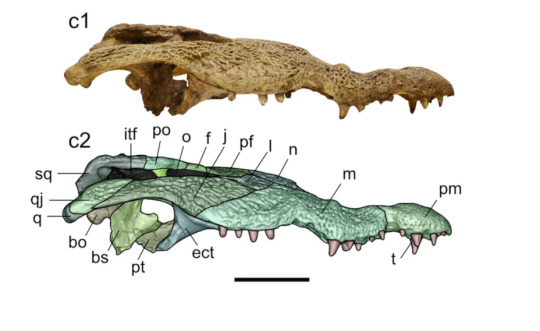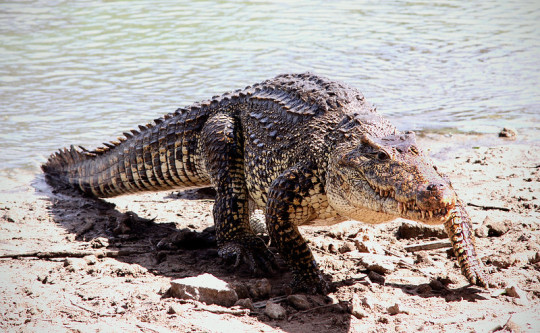#cuban crocodile
Text
Animal of the Day!
Cuban Crocodile (Crocodylus rhombifer)

(Photo from Louisville Zoo)
Conservation Status- Critically Endangered
Habitat- Western Cuba
Size (Weight/Length)- 75 kg; 2.2 m
Diet- Small mammals; Fish; Turtles
Cool Facts- Do yourself a favor and watch a video of a Cuban crocodile galloping. These highly territorial reptiles have small dog energy and are willing to chase off the much larger American alligator that they share their home with. Cuban crocodiles may be the only crocodile to hunt in coordinated packs to take down much larger prey, showing off extraordinary levels of intelligence. Sadly, Cuban crocodiles are almost extinct in the wild due to mass hunting for their skin and meat, along with general fear for territorial predators. Luckily, zoos across the world are captive breeding Cuban crocodiles with hope for reintroduction to the wild.
Rating- 13/10 (Can run 35 kilometers per hour.)
#animal of the day#animals#reptiles#crocodiles#tuesday#january 9#cuban crocodile#biology#science#conservation#the more you know
156 notes
·
View notes
Text
So something that a lot of people are seemingly unaware off is the "rostral boss" or simply face bump seen in some American Crocodiles (Crocodylus acutus). I've seen it a few times now that folks are really surprised to see it, so I think its worth sharing a bit on that and its importance to understanding how crocs came to America.
For starters, the rostral boss is a large bump that is located on the snout of some crocodiles just before the eyes, covering the back of the nasal bone and areas of the prefrontals, lacrimals and parts of the frontal bone. This boss, among modern crocs, is most prominent in the American Crocodile. Sidenote, I know its a pain, but here American Crocodile (capitalized C) means Crocodylus acutus. When meaning the crocodiles of America, I'll use Neotropic crocodiles. Also tho I'm usually liberal with the term, here crocodile specifically refers to the genus Crocodylus. Good? Good. Anyhow, this kinda gives them a look thats been likened to the Triassic phytosaurs and makes individuals with said bump really distinct. Below are some pictures which show different indivudals with less and more pronounced bosses.






Now this feature is not unique to American Crocodiles (again meaning C. acutus, I know the terminology is confusing), but can be seen in at least some other neotropic Crocodylus species. Now I've yet to see images of either Morelet's or Orinoco Crocodiles with the same and they don't appear to have been recognized with them by older literature, but there are some Cuban Crocodile skulls also showing a slight boss. If you look at the two photos below, you can see an American Crocodile skull on the left and several skulls of Cuban Crocodiles on the right (from the Quaternary Sawmill Sink on the Bahamas). It's comparably subtle in the Cubans, but there is a boss present in these skulls.


The fun part is that this isn't just a random trait that these crocodiles got out of nowhere. No, the rostral boss is actually a trait thats likely to be ancestral to ALL Crocodylus species of the Neotropics (so again, Morelet's, Cubans, Orinocos and Americans). The oldest known Crocodylus species from the Americas is Crocodylus falconensis from the Pliocene of Venezuela. And guess what, it had that very same bump on its face.


But that's not where the trail ends. No. Back in the 1940s a crocodile was found in Miocene sediments of Northern Africa that had a similar bump. Meaning on the other side of the Atlantic. This was largely ignored at the time, despite the similarities to American and Cuban Crocodiles and their rostral bosses being known back then. But more recently, scientists have taken a second look at this species, Crocodylus checchiai, and concluded that it is a likely ancestor to today's Neotropic crocodiles.


We already knew that African crocodiles (Nile Crocodiles and Sacred Crocodiles) were more closely related to Neotropic crocodiles than to Australasian ones (like Salties, Freshies and Muggers), but this essentially provided some really solid evidence for how crocs got to America. Sometime between the Miocene and Pliocene, Crocodylus checchiai (or a relative or descendent) swam across the Atlantic and landed in the area around the Caribbean, spreading and giving rise to the four true crocodiles that still inhabit the region. Which I personally think is really cool.
#crocodile#crocodiles#american crocodile#evolution#cuban crocodile#morelets crocodile#orinoco crocodile#crocodylus falconensis#crocodylus checchiai#reptiles#crocs#palaeblr
270 notes
·
View notes
Text

Cuban crocodiles
By: Unknown photographer
From: Disney's Wonderful World of Knowledge
1971
70 notes
·
View notes
Text


Multiple species of crocodilians have been observed playing with flowers. They seem to especially like pink flowers. Play involves carrying flowers in their mouth, pushing them around in the water, or wearing them on the tips of their noses.
22 notes
·
View notes
Text

He's so polite ☺️
#cuban crocodile#just look at this lad#what a polite creature#I found his picture on Google and now he lives in my photo gallery#a virtual tenant in my phone :)#ash speaks
9 notes
·
View notes
Text

#endangered species#cuban crocodile#digital art#art nouveau#art#flowers#artists on tumblr#animals#flower art#old art
4 notes
·
View notes
Text

Slippin down Backstreets like a Tourist
#digital art#animal art#furry#furry art#vaporwave#glass animals#cuban crocodile#crocodile#sh4rkh4ts art#my art
29 notes
·
View notes
Photo

My Crocodile Sona, Anvordrak, presenting himself to his new audience.
Please don’t ban me for this.
3 notes
·
View notes
Photo

Kissed by the Sun
https://www.redbubble.com/shop/ap/116859934
#crocodile#croc#alligator#reptile#ilovereptiles#ilovecrocs#ilovecrocodiles#cuban croc#cuban crocodile#sunbathing#sun bath#sunning#toothy#teeth
9 notes
·
View notes
Text
youtube
These scientists are on a mission to save the endangered Cuban crocodile 🐊
#Earth #Environment #ClimateCrisis #NowThis
#now this earth#now this#solarpunk#crocodile#Cuba#endangered species#reptile#tidalpunk#cuban crocodile#Etiam Pérez Fleitas#illegal market#poaching#illegal pets#animals#Youtube
3 notes
·
View notes
Photo

Happy Pride.
----
May your party never stop.
#art#fantasy#illustration#furry#furry artist#Cuban Crocodile#original character#pride 2022#yes I'm late#I'm always late#consider July as Pride Month pt. 2 with me
2 notes
·
View notes
Text

Cuban crocodile
By: Kenneth W. Fink
From: The Complete Encyclopedia of the Animal World
1980
#cuban crocodile#crocodilian#reptile#1980#1980s#Kenneth W. Fink#The Complete Encyclopedia of the Animal World (1980)
71 notes
·
View notes
Note
https://m.facebook.com/crocfests/videos/viva-cocodrilo-cubano/906883483028499/
Is this video cute? I’ve been wondering about it for a while, and the more I think about it the iffier it gets. Thanks :)
(If the link doesn’t work, it’s a bunch of baby crocodilians in a bathtub and you could probably find the video by googling that)
Good news - everything about this video is super cute. First, some immediate green flags: this is posted by Croc Fest, which is a legitimate conservation organization (with a very fun crocodile-focused page you should totally follow if you're on FaceBook), and features babies being raised at Dragonwood Conservancy, who run an excellent breeding and release program for critically endangered Cuban crocodiles like these.
The cute noise these babies are making isn't anything communicating distress at all. Cuban crocodiles are very social, and this is the noise they make when communicating with older crocodiles in their group. Dragonwood hand-raises their Cuban crocodiles because the parents are so protective, and these babies are making that noise because they know their caretaker is safe and brings them food.
These babies don't feel uncomfortable or distressed in the slightest. Their body language is content and some of them are actively climbing on their caretaker, just as wild Cuban crocodiles would climb on older crocodiles.
Everything about this video is good, and it's one of the rare crocodilian videos to earn a cute rating! These babies are in a professional setting, being treated respectfully, and are part of an excellent program to help secure the future of their species. Great all-around!
424 notes
·
View notes
Photo

Cuban crocodile by Gerry Zambonini
16 notes
·
View notes
